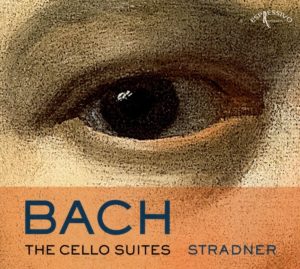
Christoph Stradner. Bach Cello Suites. Espressivo records. ESR2138. Released 2017.
Recorded 2016 at Wallrißstudio.
Stradner plays a cello by Antonio Stradivari from 1680. No information about set up or bows used.
The Cellist.
Christoph Stradner is Austrian born and at the time of publication of this CD was first solo cellist of the Vienna Symphony. He has studied with William Pleeth for a year. He includes masterclasses with Maisky, Schafran Isserlis and Geringas in his profile. Stradner is the cellist of the Altenberg Trio.
There is relatively little else to discover about this cellist on the internet so its over to his performance for us to find out more!
The Recording.
Firstly, the thing that hits me about this recording is the acoustic. The venue sounds like a stone Church or similar building with significant reverberation. I could find no information about the studio used so it could be natural or generated but sounds the former. There was no significant background noise from the performer which suggests microphone placement was not too close, again suggesting the natural acoustic is what is heard.
The cello is captured in all its glory. Not the sweetest tone or the most fulsome lower register but plenty of upper harmonics suggesting gut strings. The overarching impression is of a cellist and his instrument that is enjoying filling the venue with as much sound as possible! There is little evidence of restraint, control or holding back.
The Music.
There are plenty of clues as to what to expect in this performance from the accompanying booklet, mostly written by Stradner.
A specific concept I would pick out is of three levels of music register. “The lowest note in a phrase stands for the earth… and the highest for the godly. In between, moves the questioning human.”
I interpret this as the rationale for a very idiosyncratic interpretation. This really is a performance with tremendous variations of speed. It’s the closest to improvisation I have heard whilst keeping the notes unchanged. Of importance, is that it seems to work. The overall momentum and sense of direction is not lost amongst the timing changes. It’s almost as if there is a tension belt that tightens and loosens over each movement to keep the variations within defined boundaries.
Dynamics are not particularly marked which may come down to another belief that Stradner has: “I achieve especially strong expression through timing..”.
Whilst listening to this performance I was reminded firstly of the recent recording by Haimovitz that I have reviewed and secondly that of Martin Rummel. Haimovitz has a similarly idiosyncratic approach to timing and despite amazing virtuosity does in my view lose that sense of momentum. Rummel another Austrian plays with similar attack and speed but with more restraint on the timing side of things. I suspect if you enjoy one of these performers you will find pleasure in the interpretation of the others.
Specific points.
Aspects of Stradner’s intepretation that merit highlighting are firstly the Prelude to the fourth Suite. The arpeggio quavers are played at a terrific rate of knots and then the C sharp that closes this section is held for so long its almost as if the player has fallen asleep! Maisky in his first recording takes six and a half minutes to play this movement. Stradner plays it in three minutes six seconds. Isang Enders plays it in just under three minutes but does not sound as rushed because he doesn’t slow down so much in the middle!
If you are particular about how the fifth Suite Sarabande is played beware! Stradner goes quite fast but with a very lop-sided rhythm. This would be a nightmare for Sibelius notation software!
The fifth Prelude introductory passages suit Stradner’s style of playing with its grandness and invitation to improvisation. However once entering the fugal section, it sounds to be blunt a bit of a mess!
The third Prelude sounds a bit messy as well as the articulation is not as clear as it might be.
The sixth Allemande is beautifully played and here (perhaps paradoxically) there are less liberties taken with timing that gives this movement structure often missing in other interpretations. Unfortunately, the sense of repose is dashed by a very rushed Courante and later final Gigue!
Conclusion.
I admire Stradner’s efforts to bring something new to the Suites. However, I believe that the best way of doing this is for the player to concentrate on producing music with beautiful phrasing as clearly and rhythmically as they can. The listener can then overlay their own interpretation on top, filling in gaps and adding from their own experience. I suspect that overly fast playing and changes of speed inhibit this contribution from the listener.
I will however definitely take any opportunity to hear Stradner perform the Suites in concert as I’m sure it is a very exciting event.
Charles.